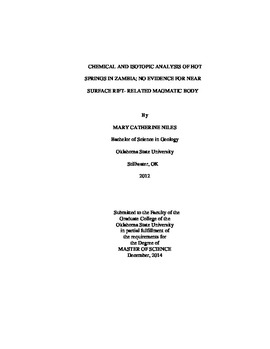| dc.contributor.advisor | Atekwana, Eliot Anong | |
| dc.contributor.author | Niles, Mary Catherine | |
| dc.date.accessioned | 2016-01-20T15:44:48Z | |
| dc.date.available | 2016-01-20T15:44:48Z | |
| dc.date.issued | 2014-12-01 | |
| dc.identifier.uri | https://hdl.handle.net/11244/25695 | |
| dc.description.abstract | Zambia exhibits extensive geothermal activity in an amagmatic rift zone. Current models for rift initiation suggest magma plays an important role in softening the lithosphere, allowing extension. In Zambia, lack of surface magmatism calls these models into question. Recent studies suggest continental scale links between the mantle and groundwater suggesting surface waters can be used as a proxy of mantle tectonism. This study investigated the geochemistry of hot/cold springs and streams within the Luangwa rift and the surrounding Proterozoic basement. The objectives were: 1) to determine if the chemistry of hot springs have a mantle derived component and 2) determine the temperature and depth of reservoirs sourcing the hot springs. Water samples collected from hot/cold springs and streams were analyzed for physical parameters, anions, cations, silica, dissolved inorganic carbon (DIC) and stable hydrogen (��D), oxygen (��18O) and carbon isotopes (��13CDIC), and reservoir temperatures were calculated. The ��D and ��18O for the cold springs and hot springs lie along a similar trend to the local meteoric water line. The DIC concentrations of hot springs are 5 to 20 mgC/L, similar to streams, lower than cold springs, 45 to 125 mgC/L. Except for one group of hot springs (the Lochinvar Group) with ��13CDIC of -6 to -4�� most of the hot springs�� range of ��13CDIC 20 to -4��. The more positive ��13CDIC of the Lochnivar Group could be from addition of magmatic body sourced CO2 or CO2 from deep sedimentary carbonates. The temperature of the hot springs ranged from 31 to 85��C. Geothermometry estimated reservoir temperatures of 150��C of the springs confirm the local geothermal gradient of 23��C/km is sufficient to generate the surface temperatures that were measured. In conclusion, (1) source of water for the hot springs is meteoric, (2) hot springs have not experienced extensive water-rock interaction, (3) CO2(g) from the soil zone is the source of DIC for most hot springs and (4) the apparent absence of magmatic influence on the ��18O and the ��13CDIC of the spring samples, means they are heated by locally high geothermal gradient at a depth of 5 km based on the reservoir temperatures. | |
| dc.format | application/pdf | |
| dc.language | en_US | |
| dc.publisher | Oklahoma State University | |
| dc.rights | Copyright is held by the author who has granted the Oklahoma State University Library the non-exclusive right to share this material in its institutional repository. Contact Digital Library Services at lib-dls@okstate.edu or 405-744-9161 for the permission policy on the use, reproduction or distribution of this material. | |
| dc.title | Chemical and Isotopic Analysis of Hot Springs in Zambia; No Evidence for near Surface Rift-related Magmatic Body | |
| dc.type | text | |
| dc.contributor.committeeMember | Atekwana, Estella Akweseh | |
| dc.contributor.committeeMember | Quan, Tracy M. | |
| osu.filename | Niles_okstate_0664M_13766.pdf | |
| osu.accesstype | Open Access | |
| dc.description.department | Geology | |
| dc.type.genre | Thesis | |
